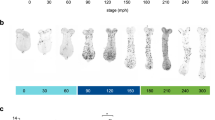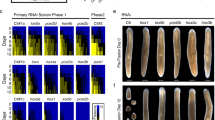Abstract
Insect segments are seriated developmental subunits whose borders largely control intra-segmental patterning1. The individual segment owes its specific character to position-dependent instructions given to its early embryonic progenitor cells2. In Drosophila, the segment borders first become visible as a series of transverse infoldings on the surface of the germ band3. We describe here development in a mutant (prdFR1) which forms half the normal number of transverse inf oldings spaced at twice the normal distance, thereby subdividing the germ band into a series of giant domains (Fig. 1 a–c). Each domain develops the tracheal pits of two normal segments (Fig. 1e), thus revealing its composite origin, but the larva expresses only one segment border per domain and the cuticle between these borders is similar to the normal segment in both size and zonation (Fig. 2). We conclude that this course of development reflects a conflict between the seriated instructions specifying local segment character (see Fig. 1b) and controlling influences exerted by the abnormally spaced infoldings and later by the definitive segment borders.
This is a preview of subscription content, access via your institution
Access options
Subscribe to this journal
Receive 51 print issues and online access
$199.00 per year
only $3.90 per issue
Buy this article
- Purchase on Springer Link
- Instant access to full article PDF
Prices may be subject to local taxes which are calculated during checkout
Similar content being viewed by others
References
Lawrence, P. A. Adv. Insect Physiol. 7, 197–266 (1970).
Sander, K. Adv. Insect Physiol. 12, 125–238 (1976).
Turner, F. R. & Mahowald, A. P. Devl Biol. 57, 403–416 (1977); 68, 96–109 (1979).
Nüsslein-Volhard, Ch. & Wieschaus, E. Nature 287, 795–801 (1980).
Lohs-Schardin, M., Cremer, Ch. & Nüsslein-Volhard, Ch. Devl biol. 73, 239–255 (1979).
Schoeller, J. Arch. Zool. exp. gén. 103, 1–216 (1964).
Lohs-Schardin, M. Drosoph. Inf. Serv. (in the press).
Nicolis, G. & Prigogine, I. Self-Organization in Nonequilibrium Systems (Wiley, New York, 1977).
Kauffman, S. A., Shymko, R. M. & Trabert, K. Science 199, 259–270 (1978).
Szabad, J., Schüpbach, T. & Wieschaus, E. Devl biol. 73, 256–271 (1979).
Lewis, E. B. Nature 276, 565–570 (1978).
Sander, K. Verh. Dt. zool. Ges. 67, 58–70 (1975).
Schubiger, G. Devl biol. 26, 277–295 (1971).
Vogel, O. Wilhelm Roux's Arch. dev. Biol. 182, 33–38 (1977).
Author information
Authors and Affiliations
Rights and permissions
About this article
Cite this article
Sander, K., Lohs-Schardin, M. & Baumann, M. Embryogenesis in a Drosophila mutant expressing half the normal segment number. Nature 287, 841–843 (1980). https://doi.org/10.1038/287841a0
Received:
Accepted:
Issue Date:
DOI: https://doi.org/10.1038/287841a0
This article is cited by
-
Reliable segmentation by successive bifurcation
Bulletin of Mathematical Biology (1995)
-
Regulation of segment polarity genes in the Drosophila blastoderm by fushi tarazu and even skipped
Nature (1988)
-
The correct activation of Antennapedia and bithorax complex genes requires the fushi tarazu gene
Nature (1986)
-
Parasegments and compartments in the Drosophila embryo
Nature (1985)
-
Near-reciprocal phenotypes caused by inactivation or indiscriminate expression of the Drosophila segmentation gene ftz
Nature (1985)
Comments
By submitting a comment you agree to abide by our Terms and Community Guidelines. If you find something abusive or that does not comply with our terms or guidelines please flag it as inappropriate.



